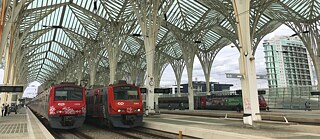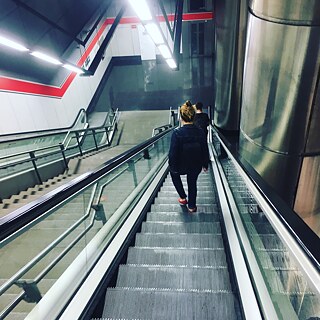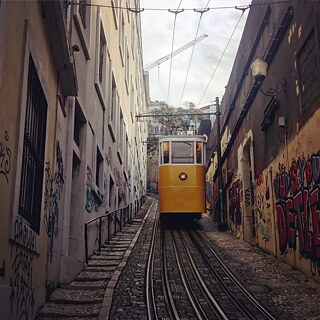Commuting
A Blessing or a Curse?

More and more people live outside the major urban centres – either because they prefer peace and quiet to the hustle and bustle of the big city, or because they simply cannot afford to live in town on account of the high property prices. To get to work, many people nowadays opt – for the sake of the environment – to take public transport rather than a car. Employees at the Goethe-Institut branches in Portugal, Spain, France and Belgium talk about their personal experiences of using the local public transport network for their daily commute to work.
By the Internet editors of the Southwest Europe region
Commuter Trains – Cheap, Relaxing and Good for the Environment (Madrid, Spain)
16 km | 60 minutes | By foot, by commuter train, by bus/underground train, by foot | 63.70 € / month
It takes me about 13 minutes to get from my home to Valdelasfuentes station, and another 21 minutes on the train to travel to Nuevos Ministerios station in Madrid. Then I normally catch the bus at Paseo de la Castellana, which drops me off next to the German Embassy in Madrid, just five minutes’ walk from my work. Door to door, the journey takes me around one hour. Considering that I live right on the outskirts of Madrid, however, I really can’t complain. Normally I use the travel time to read the free newspaper that is handed out at the station. That’s how I find out what’s happening and slowly wake up while watching the countryside pass by through the window.
My morning commute not only wakes me up, however, but also has other advantages. It is eco-friendly and good for my health because it means I avoid the stress that I would inevitably experience if I travelled by car into the centre of Madrid. What is more, it’s cheaper, as I can use the entire transport network of Madrid and San Sebastián de los Reyes for 63.70 euros a month.
In other words, it has nothing but advantages for me so long as the train doors don’t shut right in front of me after I’ve just risked my life sprinting down the platform. But okay, you can also regard that as a good bit of exercise, so even that’s yet another advantage!
The Lift – An Indispensable Friend in the City of the Seven Hills (Lisbon, Portugal)
11 km | 40 minutes | By foot, suburban train (underground), lift | 40 € / month

8:48: When she arrives at Lisbon’s city-centre station Rossio, she has to hurry. She rushes down the steps into the tunnel of Restauradores metro station – not because she has to catch an underground train, however; she uses it as a short-cut and to keep dry when it’s raining.
Our colleague already has the worst of her commute behind her. She emerges from the metro station, dashes across Avenida da Liberdade and then has to run because the Elevador do Lavra, Lisbon’s oldest lift that conveys passengers up to the Campo dos Mártires da Pátria, won’t wait! In a hilly city like Lisbon, the lift is more than just a pretty photo opportunity for tourists, it’s also a vital means of transport for students and others who work at the top of the hill.
At 9 am on the dot, the doors of this historic vehicle close. After a journey of three minutes, it’s just a few more minutes by foot to the Goethe-Institut. Our colleague arrives at the office at 9:06 am and starts her work day. Her return commute is the same, but with less time pressure and stress!
The Train – The Calm Before the Storm (Paris, France)
100 km | 120 minutes | Car, train, underground | 390.20 € / month (financial support from employer and region)

It takes me about twelve minutes to get from my home to the station by car, which I can park there free of charge. That said, spaces are few and far between as there are more and more commuters every year. Normally I take the train at 7:34 am and arrive, if all goes smoothly, in Paris-Montparnasse at 8:53 am. Then I take metro line 6 and travel ten stations to Boissière, which is five minutes’ walk from the institute. From door to door it takes me two hours in all; when there are strikes or any delays, which is almost a daily occurrence in France, it naturally takes me even longer.
The journey by train does not bother me because I always get a seat and don’t have to change. During the trip, which takes more than one hour, I can switch off quite well and read in peace, listen to music or the news, read my post and catch up with all the things I often don’t have time for. Looking out of the window at the passing countryside or taking a short nap ensures that I arrive in Paris rested and relaxed. Sometimes I also get into conversation with other commuters, as one gets to know each other over time…
By contrast, the metro is anonymous and everyone seems annoyed because too many people are simultaneously trying to get to their destinations as quickly as possible. On my line I have to wait ten minutes on some mornings before I can even board the train – and then we frequently end up stuck in a tunnel somewhere. When that happens one has to keep one’s eyes open for pickpockets!
The return journey is less stressful, but I do have to leave the office punctually so that I don’t miss the train and can get home in a relaxed mood. Even though my commute doesn’t always go smoothly, I do not regret my decision!
My Commute to Work – From the Flemish Provinces to Brussels
11.6 km / 35-60 minutes (depending on means of transport and traffic situation) | Bus/bike, underground, by foot
When I set off from home, I see fields and meadows. I walk roughly eight minutes to the bus stop and hope that the bus is on time so I don’t have to wait too long. The bus only goes weekday mornings and afternoons to take passengers to school, to work and to the metro and back, and is used very heavily. Unfortunately, it often gets stuck in traffic jams because it crosses the slip roads onto and off the Brussels ring road, so it usually takes longer than the scheduled eleven minutes.
When the weather is okay, I prefer to cycle the 15 minutes to the metro on my bike. Kitted out with good lights and a helmet, I cruise past the traffic jam, though I do have to watch out that I don’t get blown away. This part of the route is not exactly relaxing, but it means I exert my muscles and my brain – also a good thing.
Because the route into town is very busy and hilly, I take the metro. Sometimes a train is cancelled or delayed, and sometimes it is completely overcrowded, but it does transport me safely into the city. During the journey, which is supposed to take 14 minutes, I read or people-watch, though it is only now after more than two years that I occasionally see somebody I have come across before in the metro, even though I always travel at the same time. I consciously use this time to focus on me so that I get off to a good start to my work day or can switch off for a little while in the evening so I’m fit and ready for my family.
I walk the last part of the journey so as not to have to change trains again – that’s another eight minutes on foot, including what feels like an age waiting at the red light on Rue Belliard, which is where our institute used to be based, and will be again in the future.